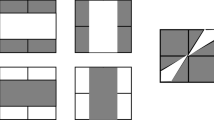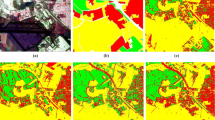Abstract
Multi frequency polarimetric sar data classification requires to consider the polarimetrie information from each data set simultaneously.
Dual data sets are classified using an iterative k-mean algorithm based on a maximum likelihood decision rule evaluated from the Wishart polarimetrie density of the 6×6 coherency matrix.
An alternative technique is also proposed which introduces the polarimetrie cross-correlation information to refine the results of classification to a small number of clusters using the conditional probability of the cross-correlation matrix.
Both new multi frequency polarimetric sar data classification methods are applied to sar data acquired over the Nezer forest (nasa /jpl AirSAR database (1989)).
Résumé
La classification de données sar polarimétriques multifréquences appairées nécessite la prise en compte de façon simultanée de ľinformation polarimétrique totale de chacune des images. Les données appairées sont classées au moyen ďun algorithme itératif des k-moyens basé sur une règle de décision au maximum de vraisemblance évaluée à partir de la densité de probabilité de Wishart de la matrice de cohérence polarimétrique 6×6.
Une seconde méthode est proposée qui, à partir de ľinformation liée à ľintercorrélation polarimétrique, permet ďaffiner les résultats ďune classification avec un nombre de classes peu élevé, en créant des classes de façon itérative à partir du calcul de la densité de probabilité conditionnelle de la matrice ďintercorrélation.
Les deux nouvelles méthodes de classification de données sar polarimétriques multi-fréquence appairées sont appliquées sur des images SAR polarimétriques de la forêt de Nezer (nasa /jpl AirSAR database (1989)).
Similar content being viewed by others

References
Rignot (E.), Chellappa (R.), Dubois (P.), “Unsupervised Segmentation of Polarimetric sar Data Using the Covariance Matrix”IEEE Transactions on Geoscience and Remote Sensing,30, n° 4, pp. 697–705, July 1992.
Zebker (H.A.), Van Zyl (J.J.), Durden (S L), Norikane (L), “Calibrated imaging radar Polarimetry: techniques examples et applications”,ieee Transactions on Geoscience and Remote Sensing, vol. 29, pp. 942–961, 1991.
Hara, Atkins (R.G.), Yueh (S.H.), Shin (R.T.), Kong (J.A.), “Application of Neural Networks to Radar Image Classification”,ieee Transactions on Geoscience and Remote Sensing, vol. 32, January 1994, pp. 100–110.
Van Zyl (J.J.), Burnette (CF.), “Bayesian classification of polarimetric sar images using adaptive a-priori probabilities”,International Journal of Remote Sensing,13, pp. 835–840, 1992.
Potter (E.), “On Full Polarimetrie Target Decomposition Theorems with Application to Classification et Identification of Real Target Cross Section”,Proceedings of International Radar Conference, Paris, pp. 330–335, May 1994.
Van Zyl (J.J.) “Unsupervised classification of scattering behavior using radar polarimetry data”,ieee Transactions on Geoscience and Remote Sensing, vol. 27, pp. 36–45, 1989.
Boerner (W.M.) et al “Polarimetry in Radar Remote Sensing: Basic et Applied Concepts” Chapter 5Principles et Applications of Imaging Radar, The Manual of Remote Sensing, 3rd Edition, The American Society for Photogrammetry et Remote Sensing, March 1998.
Huynen (J.R.), “Phenomenological theory of radar targets ”, Ph.D. dissertation,Drukkerij Bronder-offset, N.V Rotterdam, 1970.
Cloude (S.R.), Pottier (E.), “A Review of Target Decomposition Theorems in Radar Polarimetry”,ieee Transactions on Geoscience and Remote Sensing,34, n° 2, pp. 498–518, September 1995.
Cloude (S.R.), Pottier (E.) “An Entropy Based Classification Scheme for Land Applications of Polarimetrie sar”,ieee Transactions on Geoscience and Remote Sensing,35, n° 1, pp. 68–78, January 1997.
Freeman (A.),Durden (S.) “A three component scattering model to describe polarimetrie sar data”,spie Vol 1748, Radar Polarimetry, pp. 213–225, 1992.
Dong (Y.), Forster (B.), Ticehurst (C), “A New Decomposition of Radar Polarization Signatures”,ieee Transactions on Geoscience and Remote Sensing,36, n° 3, pp. 933–939, 1998.
Shi (J.), Dozier (J.), “On estimation of Snow Water Equivalence using SIR-c/X-sar”, Proceedings of theSecond International Workshop on Retrieval of Bio- et Geo-physical Parameters from sar Data for Land Application, Noordwijk, The Netherlands, October 1998.
Floricioiu (D.M.), “Polarimetrie Signatures et Classification of Alpine Terrain by Means of sir-c/x-sar”, Ph. D. dissertation, Innsbruck, Austria, 1997.
Chen (K.S.), et al., “Classification of Multifrequency Polarimetrie sap, Image Using a Dynamic Learning Neural Network”,ieee Transactions on Geoscience and Remote Sensing,34, n° 3, pp. 814–820, 1996.
Freeman (A.), Durden (S.), Zimmerman (R.), “Mapping Sub-Tropical Vegetation using Multi-Frequency Multi-Polarization sar data”, Proceedings ofigarss, June 1992, Houston, usa, pp. 1686–1689.
Lee (J.S.), Grunes (M.R.), Kwok (R.), “Classification of multilook polarimetrie SAR imagery based on the complex Wishart distribution”,International Journal of Remote Sensing,15, n° 11, pp. 2299–2311, 1994.
Kong (J.A.),Yueh (S.H.),Shin (R.T.),Van Zyl (J.J.), “Classification of Earth Terrain using Polarimetrie Synthetic Aperture Radar Images”, Chapter 6 inpier Volume 3, ed. J.A. Kong Elsevier 1990.
Lee (J.S.), Grunes (M.R.), Ainsworth (T.L.), Du (L.), Schuler (D.L.) etCloude (S.R.), “Unsupervized Classification of Polarimetric sar Images by Applying Target Decomposition et Complex Wishart Distribution”,ieee Transactions on Geoscience and Remote Sensing, vol. 37, n°5, pp2249–2258, Sept. 1999, alsoProceedings of the Fourth International Workshop on Radar Polarimetry, piers 1998, Nantes, France, 13-17 July 1998.
Cloude (S.R.), Papathanassiou (K.P) “Polarimetrie sar Interferometry”,ieee Trans. Geoscience and Remote Sensing, 36, n°5, pp. 1551–1565, 1998.
Ferro-Famil (L.), Pottier (E.), Dedieu (J.P.), Corgier (C), Saillard (J.), “Application of Polarimetrie sar data processing to Snow Cover Remote Sensing. Validation using Optical images et Ground data”, proceedings of theCommittee on Earth Observing Satellites sar Workshop, cnes, Toulouse, France, 26–29 October 1999.
Goodman (N.R.), “Statistical analysis based on a certain multivariate complex Gaussian distribution (an introduction),”Annals of Mathematics and Statistics, 34, pp. 152–177, 1963.
Muirhead (R.J.),“Aspects of Multivariate Statistical Theory”, John Wiley et Sons, New-York, isbn 0-471-094442-0.
Pottier (E.), Lee (J.S.), “Application of the H7A/alpha Polarimetric Decomposition Theorem For Unsupervised Classification of fully Polarimetrie SAR data based on The Wishart Distribution ”, proceedings of theCommittee on Earth Observing Satellites SAR Workshop, cnes, Toulouse, France, 26–29 October 1999.
Author information
Authors and Affiliations
Corresponding authors
Rights and permissions
About this article
Cite this article
Ferro-Famil, L., Pottier, E. Classification de données SAR multifréquences polarimétriques. Ann. Télécommun. 56, 510–522 (2001). https://doi.org/10.1007/BF03008829
Received:
Accepted:
Issue Date:
DOI: https://doi.org/10.1007/BF03008829
Key words
- Remote sensing
- Synthetic aperture radar
- Polarimetry
- Multifrequency operation
- Data analysis
- Automatic classification
- Vegetation



